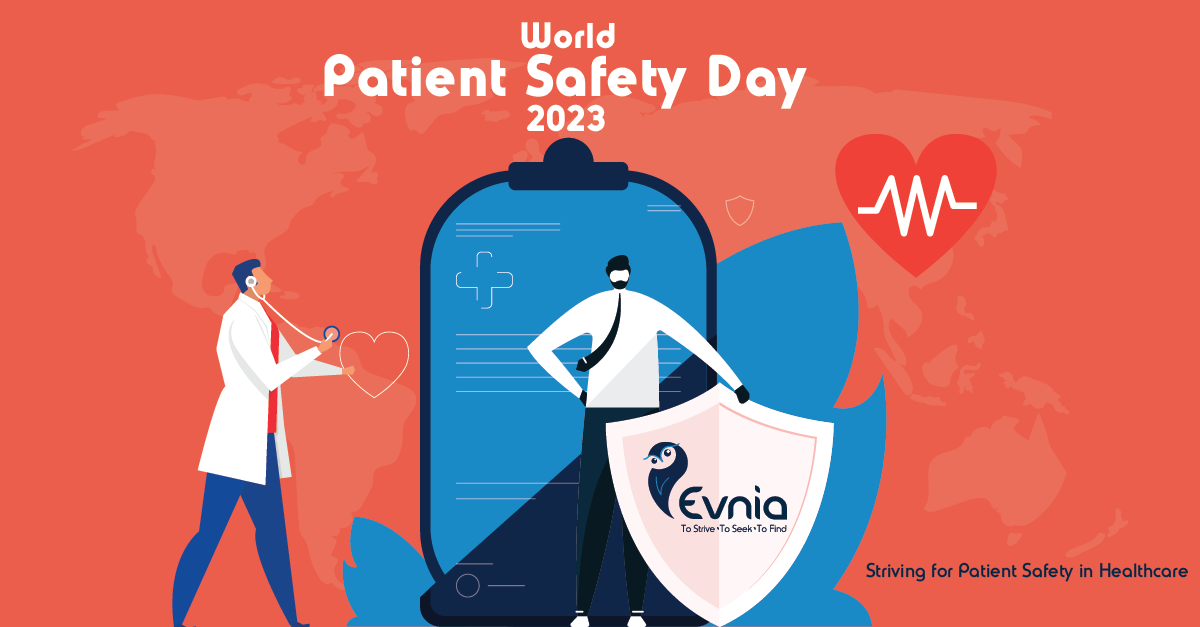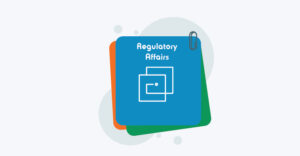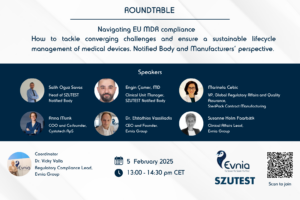With the upcoming World Patient Safety Day approaching, our team took some time to reflect on some questions regarding patient safety: What does it mean to them? How do we contribute to patient safety here at Evnia? How does the future look for patient safety, and what improvement to they seek to see in patient safety in the next years?
These are their thoughts and reflections:
“The main motivation for my work is that it has a direct impact on the patients’ lives and their safety. Patient’s safety is the centre of my everyday workflow, which inspires me to see the actual end user of my work.”
Dr Anna Karapatsia (M.Eng., PhD), Senior Medical Writer
“Patient safety to me signifies a paramount commitment to identifying, addressing and disclosing any potential risks or harms linked to the use of a medical device. Ensuring patient safety also involves safeguarding patients from unsupported manufacturer claims that often leverage emerging technologies and misinformation, which can lead to unrealistic patient expectations. In essence, it means shielding patients from those who may exploit their hopes, a situation that can commonly arise with the introduction of new technologies that have a market momentum and a capable marketing department that can silence the risks and highlight the benefits.”
Benjamin Polatidis (M.Sc., M.Eng.), Medical Writer
“It means ensuring that any treatment/therapy given to a patient is as safe as it can be whilst being able to provide a positive benefit/outcome for the patient. To me, patient safety should be the top priority.”
Dr Amy Lewis (Ph.D., M.Sc., B.Sc.), Medical Writer
“Patient safety is a given in our business and it is the cornerstone in every activity that we are involved in.”
Susanne Faarbæk (B. Sc.), Senior Clinical Lead
“For me, patient safety corresponds to feeling safe while being in a hospital/clinic environment but also while experiencing everyday life and does not have an abstract meaning. The most important thing for me is to always improve the quality of life of actual and/or upcoming patients and to keep the whole community as safe as possible.”
Angeliki Koukoura (M.Sc., B.Sc.), Clinical Data Manager
“Patient safety to me is taking all the measures possible in all aspects of clinical practice or during research that ensure that the patient will be covered for potential adverse events during their treatment/ period of participation in the study. It could be that the clinician (and all the personnel treating the patient) is following a standardize procedure during patient visit /treatment. In a case of a clinical research (clinical trial, registry etc) that all the appropriate measures have been taken to assure patients safety (inform consent, patient insurance, following the protocol closely etc).”
Kyriaki Antonopoulou (M.Sc. Biostatistics), Senior Biostatistician
“Patient safety also means acknowledging that every patient has unique needs, life experiences and a different social background which is crucial in supplying the best possible medical treatments. Psychological support, patience, and compassion from healthcare providers are more valuable than any medicine or clinical protocol in managing chronic, disabling, rare diseases or mental disorders.”
Davide Anastasi (M.Sc. Medical Biotechnology, B.Sc. Biomedical Science), Medical Writer
“At Evnia, we conduct clinical evaluations of medical devices to ensure that the benefit they provide to the patient outweighs any potential risks. We identify and evaluate all potential risks posed by a device and aim to reduce them as far as possible, therefore focusing on patient safety.”
Dr Amy Lewis (Ph.D., M.Sc., B.Sc.), Medical Writer
“Evnia is fully engaged into protect patient safety by deploying a range of services designed to support and guide the complex network of stakeholders involved into healthcare system. Informative contents on LinkedIn, white papers and infographics, social events and campaigns are just a few of the activities Evnia has implemented to contribute to the joint efforts of healthcare professionals, regulatory authorities, manufacturers.”
Davide Anastasi (M.Sc. Medical Biotechnology, B.Sc. Biomedical Science), Medical Writer
“Evnia contributes to patient safety every day through the creation of clinical and regulatory-compliant documentation to assess the performance and safety of medical devices, with the goal of ensuring that patient safety is never compromised.”
Anna Iadarola (M.Sc. Pharmacy & Industrial Pharmacy), Medical Writer
“We are keeping a critical eye on provided data and advising our clients to incorporate more studies/collect more data from different sources to ensure that their devices are safe to use.”
Dr Paraskevi Charitou (Ph.D.), Senior Medical Writer
“Evnia contributes directly to patient safety via all the dedicated clinical research services (since we conduct actual research to evaluate the safety and performance of medical devices that are used in actual patients in the everyday life setting) but also indirectly through the clinical evaluations in which we evaluate again the safety and performance of medical devices via another point of view.”
Angeliki Koukoura (M.Sc., B.Sc.), Clinical Data Manager
“The future for patient safety means big data and digital health technologies, entailing multiple benefits such as better access to a “bird-eye view” over safety metrics but also increased risks for cybersecurity and for breach of personal information, introducing new discussions on the practices, the ethics and on the ownership of personal data. The future also will include Artificial intelligence and machine learning technologies for image analysis, clinical decision support systems or for predictive analytics concerning patient treatment.”
Benjamin Polatidis (M.Sc., M.Eng.), Medical Writer
“There is an enhanced focus on patient’s right to safe treatment and care with the use of medical devices underlined in the increased documentation requirements described in Medical Device Regulation (MDR). When having a medical device on the European market following the MDR is mandatory, therefore, patient safety is expected to improve for existing medical devices on the European market and for new medical devices.”
Dr Gitte Juel Holst (Ph. D.), Clinical Study Manager
“With advancements in medical technology and healthcare services, healthcare providers have more tools at their disposal to better predict and prevent adverse events that could harm patients. Telemedicine will be an integrated component of Healthcare system to provide an early access to health-related services, personalized (and precision) medicine will be the standard protocol to diagnose, treat, monitor and prevent diseases and medical conditions based on patients’ needs, regulations and national/international laws, supported by scientific and ethical committees, will protect patients’ health and privacy from unnecessary and potential risks.”
Davide Anastasi (M.Sc. Medical Biotechnology, B.Sc. Biomedical Science), Medical Writer
“An official board within international health and government institutions will aspire to a standardization in procedures and regulation within the health fields.”
Oscar Garza-Villarreal (MD. Gynaecology and infertility), Medical Writer
“I think the future looks good for patient safety. For example, within the medical device industry, the new MDR regulation imposes stricter post-market surveillance of medical devices, which monitors the real-world use of the devices and thereby improves patient safety by monitoring any known and unforeseen risks.”
Dr Amy Lewis (Ph.D., M.Sc., B.Sc.) Medical Writer
“Latest advances in technologies (i.e., artificial intelligence-based systems) can provide better insights into identification of harms, prevention and eliminate user error, amongst other advantages. Safer technologies = patient safety.”
Dr Konstantina Nadia Tzelepi (Ph.D., MRes, BSc Hons), Project Manager
“The higher the life expectancy becomes, the more prevalent are the health issues that humans have to deal with. The need for healthcare services is constantly increasing. It is crucial the highest need to be addressed by safe medical devices without any compromise in view of the demand. The global trend of healthcare authorities is to align with the stricter requirements of European Union, namely MDR, for the circulation of medical devices in the market and for the launch of innovative devices. Flexibility of the processes that are associated with the release in the market for the new and innovative devices is of key importance, thereby the technological progress entails a vast availability of innovative medical devices with software and AI incorporation.”
Dr Anna Karapatsia (M.Eng., PhD), Senior Medical Writer
“The most important for me is to standardize procedure in every possible aspect of clinical practice to minimize errors.”
Kyriaki Antonopoulou (M.Sc. Biostatistics), Senior Biostatistician
“I’d like to see further improvements in patient access to safety information, so that patients can make informed choices about any treatment/therapy they may be offered.”
Dr Amy Lewis (Ph.D., M.Sc., B.Sc.) Medical Writer
“I would suggest more standardised safety protocols across healthcare organisations so that medical treatment is consistent, and every patient receives the same level of care. Additionally, it is crucial to involve patients more in the healthcare process and to collaborate with healthcare providers to maintain safety. For this to be effective, healthcare providers must transparently uphold safety standards and be accountable for them across the industry.”
Davide Anastasi (M.Sc. Medical Biotechnology, B.Sc. Biomedical Science), Medical Writer
“More clinical studies, especially on vulnerable populations.”
Dr Paraskevi Charitou (Ph.D.), Senior Medical Writer
“To ensure sustainable and meaningful improvements in health care safety in the coming years, clear policies, organisational leadership capacity, data quality to promote safety improvements, qualified health care professionals, and the continued active and effective involvement of patients and families in the care process are needed.”
Anna Iadarola (M.Sc. Pharmacy & Industrial Pharmacy), Medical Writer
“I seek to see that Clinical Investigations are designed to meet scientifically relevant endpoints with sample sizes that are statistically justifiable.”
Susanne Faarbæk (B. Sc.), Senior Clinical Lead
“General acceptance of the importance of continuous documentation of medical devices’ safety and performance to ensure that patients are only exposed to high quality medical devices when receiving health care and treatment”
Dr Gitte Juel Holst (Ph. D.), Clinical Study Manager
“Standardisation in patient care-procedures as well as regulation regarding a hospital-clinic care environment and through the implementation of regulation to monitor and enforce it.”
Oscar Garza-Villarreal (MD. Gynaecology and infertility), Medical Writer
“Integrated risk management that can lead to changes in clinical practice, promote the growth of a culture of health that is more caring and closer to both patient and caregiver, indirectly contribute to a decrease in the cost of care, and, finally, encourage the allocation of resources on interventions aimed at developing safer and more efficient health care organisations and facilities.”
Anna Iadarola (M.Sc. Pharmacy & Industrial Pharmacy), Medical Writer
“Improvements in systems’ qualities, meaning intended uses and applications backed by sufficient clinical evidence. Also, improvements in the regulatory frameworks of each country and effective implementation/enforcement of these regulations for market authorisations.”
Dr Konstantina Nadia Tzelepi (Ph.D., MRes, BSc Hons), Project Manager





